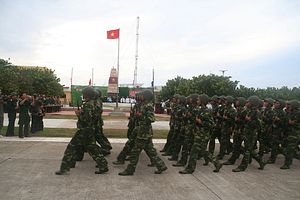On June 22, Vietnam and the Philippines conducted the third iteration of their naval personnel interactions on Southwest Cay in the Spratly Islands in the South China Sea. In doing so, both sides have effectively resumed an intra-ASEAN confidence-building activity in the disputed waters even amid the recent changes in dynamics in the South China Sea.
Until the inauguration of Philippine President Rodrigo Duterte, Vietnam and the Philippines had been significantly strengthening their maritime collaboration as well as their broader relationship for several reasons, including China’s growing assertiveness in the South China Sea. The two sides had come up with mechanisms from hotlines to working groups to facilitate confidence-building, and the relationship was elevated to a strategic partnership in 2015 under Duterte’s predecessor, Benigno Aquino III (See: “Philippines, Vietnam to Ink Strategic Partnership by End of 2015”).
One of the string of agreements reached during this time in the maritime realm was a 2012 protocol for bilateral naval exchanges on Southwest Cay, currently occupied by Vietnam, and Northeast Cay, occupied by the Philippines. At the time, the interaction between the two countries was hailed as an example of intra-ASEAN confidence building in the South China Sea at a time of heightened tensions.
This was especially the case given the history of the struggle between the two ASEAN states to control the two features, which lie only a few miles from each other. Both Southwest Cay and Northeast Cay were initially occupied by the South Vietnamese government following their transfer from France. But they were subsequently occupied by the Philippines, after which the South Vietnam government reoccupied Southwest Cay, leaving Manila with just Northeast Cay.
Under the new initiative, both Manila and Hanoi had agreed to rotate naval personnel exchanges between their respective features, with a series of confidence-building measures including sports activities as well as substantive information sharing.
The idea was to both improve ties between the two sides but also send a clear signal that fellow ASEAN claimants can narrow their differences and behave in ways that are in accordance with regional confidence-building measures such as the Declaration on the Conduct on the South China Sea (DoC) inked between ASEAN and China back in 1992, even if China continued to violate the DoC and drag its feet on a legally binding CoC (See: “Beware the Illusion of China-ASEAN South China Sea Breakthroughs”).
The first of these exchanges were conducted in Vietnam-controlled Southwest Cay back in June 2014, shortly after China had placed an oil rig inside Vietnam’s exclusive economic zone (EEZ). The second iteration occurred in late May 2015 in Philippine-controlled Northeast Cay, following the alternating pattern both sides initially agreed to.
But, interestingly, no interaction was held in 2016. Assuming that both sides would have held it around May or June 2016 (which would be consistent with the timing of the two previous ones) it would have been rather awkward timing. The exchange would have occurred right around the transition from Aquino to Duterte, who was inaugurated on June 30 following his victory in the Philippine presidential election in early May.
This is especially the case given the starkly different note Duterte had struck from Aquino both on the South China Sea as well as on ties to Beijing and Washington, even though officials continued to stress that there was more continuity than has often been acknowledged (See: “The Truth About Duterte’s ASEAN South China Sea Blow”).
On June 22 of this year, both sides effectively resumed this interaction. According to the Philippine Navy, the “third personnel interaction” consisted of the usual mix of confidence-building activities including sports, such as football, volleyball and tug-of-war; visits, such as to a lighthouse and a pagoda; and substantive information-sharing in areas including search and rescue, maritime security, disaster prevention, and communication enhancement between the two features.
In official statements, both defense establishments emphasized the continuity of the interaction in the context of their wider cooperation. But as with many other developments of this ilk, the timing of the resumption this year will be read in the context of other events in the South China Sea and in their relationships with China.
As I noted in a piece last week, Sino-Vietnamese tensions in the South China Sea still continue to flare up from time to time, and Hanoi remains wary of Beijing’s continued assertiveness (See: “Nixed China-Vietnam Meeting Highlights Illusion of South China Sea Calm”).
And though China and the Philippines have been keen to emphasize constructive steps they have taken, including the start of bilateral consultations in the Duterte era in May, both sides have thus far made little headway in resolving thorny questions. Defense officials have said that Manila is quietly continuing many of the previous efforts it took to safeguard its South China Sea claims.
To be sure, one ought not to overstate the significance of a single interaction, either within the Vietnam-Philippine bilateral relationship or the broader strategic dynamics of the South China Sea. But the resumption of this Philippines-Vietnam naval personnel exchange is certainly an interesting development that bears careful watching, even if it does not generate as many headlines as the flashpoints that periodically occur.































